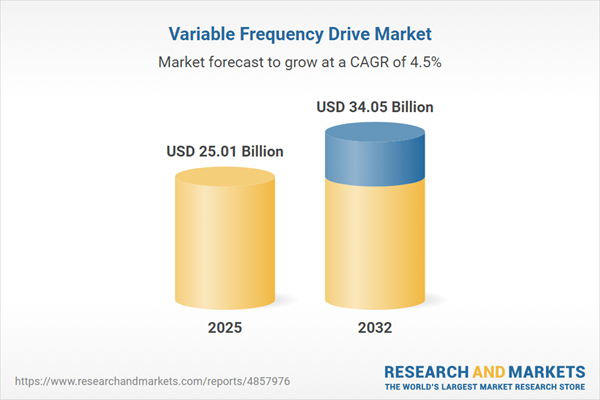Speak directly to the analyst to clarify any post sales queries you may have.
The Variable Frequency Drive market is undergoing rapid transformation, providing critical capabilities in energy efficiency, operational agility, and advanced process control for industrial leaders facing evolving regulatory and technological demands.
Market Snapshot: Variable Frequency Drive Market Growth
The Variable Frequency Drive Market grew from USD 24.03 billion in 2024 to USD 25.01 billion in 2025. It is expected to continue growing at a CAGR of 4.45%, reaching USD 34.05 billion by 2032.
Scope & Segmentation of the Variable Frequency Drive Market
- Product Type: AC Drives, DC Drives, Servo Drives
- Voltage: Low Voltage, Medium Voltage
- Power Rating: High Power (Above 200 kW), Low Power (0 kW - 0.75 kW), Medium Power (0.75 kW - 200 kW)
- Application: Compressors (Reciprocating, Screw), Conveyors (Belt, Roller), Extruders (Metal, Plastic), Fans and Blowers (HVAC, Industrial), Pumps (Centrifugal, Diaphragm)
- End User: Agriculture, Chemical & Petrochemical, Energy & Power, Food & Beverage, Marine & Shipbuilding, Oil & Gas
- Geography: Americas (North America [United States, Canada, Mexico], Latin America [Brazil, Argentina, Chile, Colombia, Peru]), Europe, Middle East & Africa (Europe [United Kingdom, Germany, France, Russia, Italy, Spain, Netherlands, Sweden, Poland, Switzerland], Middle East [United Arab Emirates, Saudi Arabia, Qatar, Turkey, Israel], Africa [South Africa, Nigeria, Egypt, Kenya]), Asia-Pacific (China, India, Japan, Australia, South Korea, Indonesia, Thailand, Malaysia, Singapore, Taiwan)
- Company Coverage: ABB Ltd., Anaheim Automation, Carlo Gavazzi Holding, CG Power, Danfoss A/S, Delta Electronics, Eaton Corporation, Fuji Electric, General Electric, Getriebebau NORD, Hitachi, Honeywell, Inovance Technology Europe, Johnson Controls, Larsen & Toubro, Mitsubishi Electric, Nidec Corporation, Parker-Hannifin, Rockwell Automation, Schneider Electric, SEW-EURODRIVE, Shenzhen Gozuk, Shenzhen INVT Electric, Siemens AG, Sprint Electric, Sumitomo Heavy Industries, WEG S.A., Yaskawa Electric
Key Takeaways for Senior Decision-Makers
- Variable Frequency Drive solutions are adopted to enable precise motor control that supports industrial sustainability initiatives and efficiency goals.
- Integration with IoT, edge computing, and digital twins allows for advanced predictive maintenance, reducing downtime and extending operational lifespan.
- Segment-specific requirements, such as harmonic mitigation and feedback integration, drive tailored product design in both high-precision and high-power applications.
- Emerging markets in Asia-Pacific are experiencing the fastest adoption due to growing manufacturing capacity and complex energy environments.
- Original equipment manufacturers and end users increasingly collaborate with suppliers to design application-specific drives that address unique process challenges.
- Strategic focus on modular and scalable architectures accelerates market responsiveness and strengthens lifecycle management.
Tariff Impact on the Variable Frequency Drive Market
United States Section 232 tariffs have affected costs and sourcing strategies for steel, semiconductors, and components critical to Variable Frequency Drive production. These duties have prompted drive manufacturers to diversify suppliers, pursue nearshoring, and strengthen inventory planning. The resulting shifts have increased competition among regional producers and encouraged vertical integration to reduce exposure to sourcing risks and lead time uncertainties throughout the industrial equipment supply chain.
Primary Keyword: Variable Frequency Drive
Methodology & Data Sources
This market analysis integrates primary interviews with manufacturers, original equipment integrators, and end-user engineering teams, alongside a rigorous review of technical journals, white papers, and regulatory data. Quantitative evaluations leverage supplier financials and operational metrics, while expert panels and data triangulation ensure practical relevance and data integrity.
Why This Report Matters
- Empowers strategic and procurement leaders with actionable market intelligence to develop competitive positioning and minimize operational risks.
- Provides a comprehensive understanding of segmentation trends and technology advances to inform capital planning, modernization, and product portfolio decisions.
- Highlights supply chain, regulatory compliance, and technology transfer dynamics, supporting confident entry and expansion into global or high-growth regions.
Conclusion
The strategic evolution of the Variable Frequency Drive market is shaped by innovation, digitalization, and changing supply chain dynamics. Senior stakeholders can use these insights to refine investment strategies and capitalize on emerging opportunities.
Additional Product Information:
- Purchase of this report includes 1 year online access with quarterly updates.
- This report can be updated on request. Please contact our Customer Experience team using the Ask a Question widget on our website.
Table of Contents
3. Executive Summary
4. Market Overview
7. Cumulative Impact of Artificial Intelligence 2025
Companies Mentioned
The companies profiled in this Variable Frequency Drive market report include:- ABB Ltd.
- Anaheim Automation, Inc.
- Carlo Gavazzi Holding AG
- CG Power and Industrial Solutions Limited
- Danfoss A/S
- Delta Electronics, Inc.
- Eaton Corporation plc
- Fuji Electric Co., Ltd.
- General Electric Company
- Getriebebau NORD GmbH & Co KG
- Hitachi Ltd.
- Honeywell International Inc.
- Inovance Technology Europe GmbH
- Johnson Controls International plc
- Larsen & Toubro Limited
- Mitsubishi Electric Corporation
- Nidec Corporation
- Parker-Hannifin Corporation
- Rockwell Automation, Inc.
- Schneider Electric SE
- SEW-EURODRIVE GmbH & Co KG
- Shenzhen Gozuk Co., Ltd
- Shenzhen INVT Electric Co., Ltd.
- Siemens AG
- Sprint Electric Limited
- Sumitomo Heavy Industries, Ltd.
- WEG S.A.
- Yaskawa Electric Corporation
Table Information
| Report Attribute | Details |
|---|---|
| No. of Pages | 198 |
| Published | November 2025 |
| Forecast Period | 2025 - 2032 |
| Estimated Market Value ( USD | $ 25.01 Billion |
| Forecasted Market Value ( USD | $ 34.05 Billion |
| Compound Annual Growth Rate | 4.4% |
| Regions Covered | Global |
| No. of Companies Mentioned | 29 |









